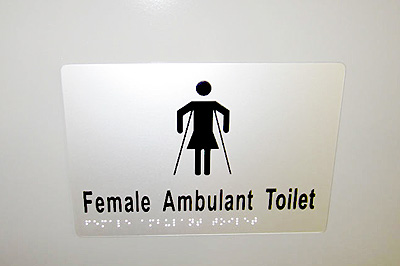
The requirement to have accessible sanitary facilities ensures people with disabilities are able to utilise a building’s sanitary facilities, and that those facilities are able to be used by them. Suitable sanitary facilities must be provided in convenient locations and that the provision of sanitary facilities should take account of the function or use of a building, the number and gender of occupants and the needs of occupants including people with a disability.
From the 1 May 2011 the Building Code of Australia /Premises Standards now states that where there are standard toilets, in addition to a required accessible unisex toilet at any bank of toilets, a compartment suitable for use by a person with an ambulant disability must also be provided for use by males and females.
If the additional toilet is a single unisex toilet for use by either sex, it must make this provision. If there are separate toilets for use by both males and females, each gender-specific toilet must make this provision.
For example, if a building was required to provide 8 toilet pans for occupants and all were located in the same part of the building as a male/female toilet block, the requirement would be:
In another example where the building is only required to be provided one male and one female toilet this provision would be met by providing a single accessible unisex toilet and ambulant toilets are not required as there are no additional toilets required.
The requirements for a compartment suitable for use by a person with an ambulant disability are detailed in Clause 16 of AS 1428.1 and include:
Tanisha Cowell looks at why Unisex Ambulant Toilets can no longer be provided as was included within the 2016 version of the Building Code of Australia that the DtS requirements require separate sanitary facilities for males and females.
Click on the following link for How big is a Disabled Toilet